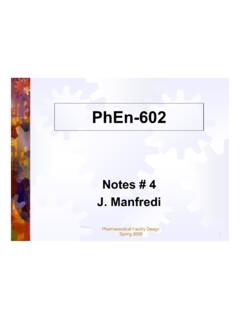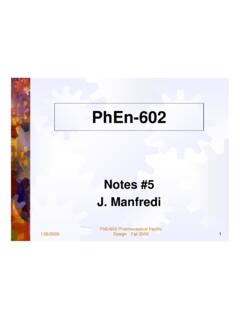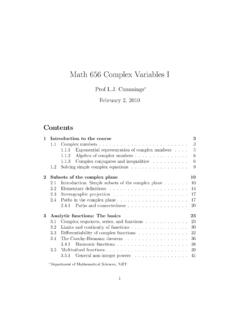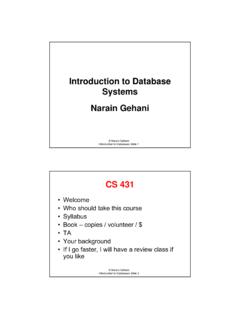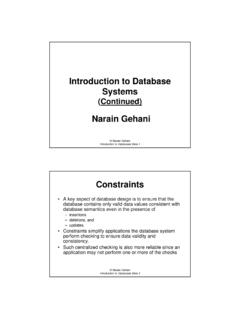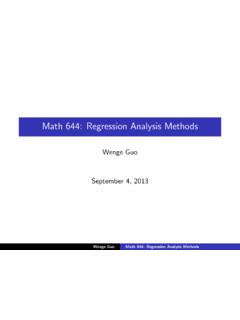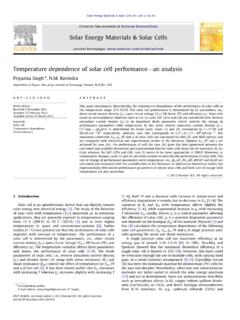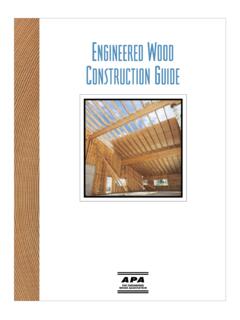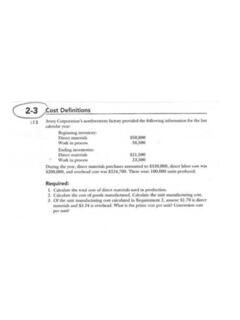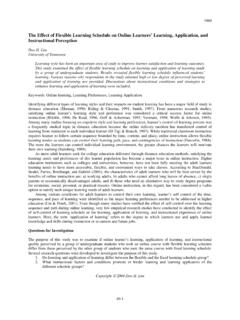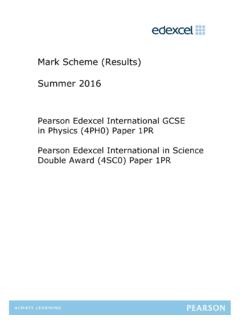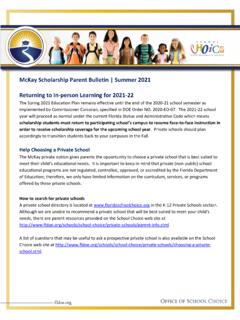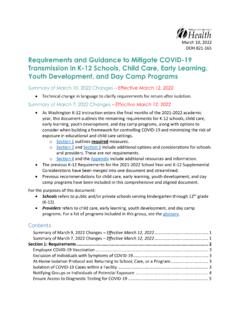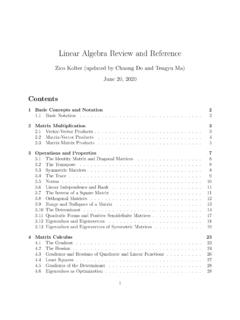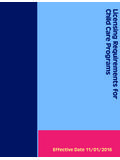Transcription of Introduction to Boosted Trees - New Jersey Institute of ...
1 Introduction to Boosted Trees TexPoint fonts used in EMF. Read the TexPoint manual before you delete this box.: AAA Tianqi Chen Oct. 22 2014 Outline Review of key concepts of supervised learning Regression Tree and Ensemble (What are we learning ) Gradient Boosting (How do we Learn) Summary Elements in Supervised learning Notations: i-th training example Model: how to make prediction given Linear model: (include linear/logistic regression) The prediction score can have different interpretations depending on the task Linear regression: is the predicted score Logistic regression: is predicted the probability of the instance being positive for example in ranking can be the rank score Parameters: the things we need to learn from data Linear model.
2 Elements continued: Objective Function Objective function that is everywhere Loss on training data: Square loss: Logistic loss: Regularization: how complicated the model is? L2 norm: L1 norm (lasso): Training Loss measures how well model fit on training data Regularization, measures complexity of model Putting known knowledge into context Ridge regression: Linear model, square loss, L2 regularization Lasso: Linear model, square loss, L1 regularization Logistic regression: Linear model, logistic loss, L2 regularization The conceptual separation between model, parameter, objective also gives you engineering benefits. Think of how you can implement SGD for both ridge regression and logistic regression Objective and Bias Variance Trade-off Why do we want to contain two component in the objective?
3 Optimizing training loss encourages predictive models Fitting well in training data at least get you close to training data which is hopefully close to the underlying distribution Optimizing regularization encourages simple models Simpler models tends to have smaller variance in future predictions, making prediction stable Training Loss measures how well model fit on training data Regularization, measures complexity of model Outline Review of key concepts of supervised learning Regression Tree and Ensemble (What are we learning ) Gradient Boosting (How do we Learn) Summary Regression Tree (CART) regression tree (also known as classification and regression tree): Decision rules same as in decision tree Contains one score in each leaf value Input: age, gender, occupation.
4 Age < 15 is male? +2 -1 + Y N Y N Does the person like computer games prediction score in each leaf Regression Tree Ensemble age < 15 is male? +2 -1 + Y N Y N Use Computer Daily Y N + tree1 tree2 f( ) = 2 + f( )= -1 + Prediction of is sum of scores predicted by each of the tree Tree Ensemble methods Very widely used, look for GBM, random Almost half of data mining competition are won by using some variants of tree ensemble methods Invariant to scaling of inputs, so you do not need to do careful features normalization. Learn higher order interaction between features. Can be scalable, and are used in Industry Put into context: Model and Parameters Model: assuming we have K Trees Think: regression tree is a function that maps the attributes to the score Parameters Including structure of each tree, and the score in the leaf Or simply use function as parameters Instead learning weights in , we are learning functions( Trees ) Space of functions containing all Regression Trees learning a tree on single variable How can we learn functions?
5 Define objective (loss, regularization), and optimize it!! Example: Consider regression tree on single input t (time) I want to predict whether I like romantic music at time t t < 2011/03/01 t < 2010/03/20 Y N Y N Equivalently The model is regression tree that splits on time Piecewise step function over time learning a step function Things we need to learn Objective for single variable regression tree(step functions) Training Loss: How will the function fit on the points? Regularization: How do we define complexity of the function? Number of splitting points, l2 norm of the height in each segment? Splitting Positions The Height in each segment learning step function (visually) Coming back: Objective for Tree Ensemble Model: assuming we have K Trees Objective Possible ways to define ?
6 Number of nodes in the tree, depth L2 norm of the leaf weights .. detailed later Training loss Complexity of the Trees Objective vs Heuristic When you talk about (decision) Trees , it is usually heuristics Split by information gain Prune the tree Maximum depth Smooth the leaf values Most heuristics maps well to objectives, taking the formal (objective) view let us know what we are learning Information gain -> training loss Pruning -> regularization defined by #nodes Max depth -> constraint on the function space Smoothing leaf values -> L2 regularization on leaf weights Regression Tree is not just for regression! Regression tree ensemble defines how you make the prediction score, it can be used for Classification, Regression, .. It all depends on how you define the objective function!
7 So far we have learned: Using Square loss Will results in common gradient Boosted machine Using Logistic loss Will results in LogitBoost Take Home Message for this section Bias-variance tradeoff is everywhere The loss + regularization objective pattern applies for regression tree learning (function learning ) We want predictive and simple functions This defines what we want to learn (objective, model). But how do we learn it? Next section Outline Review of key concepts of supervised learning Regression Tree and Ensemble (What are we learning ) Gradient Boosting (How do we Learn) Summary So How do we Learn? Objective: We can not use methods such as SGD, to find f (since they are Trees , instead of just numerical vectors) Solution: Additive Training (Boosting) Start from constant prediction, add a new function each time Model at training round t New function Keep functions added in previous round Additive Training How do we decide which f to add?
8 Optimize the objective!! The prediction at round t is Consider square loss This is what we need to decide in round t Goal: find to minimize this This is usually called residual from previous round Taylor Expansion Approximation of Loss Goal Seems still complicated except for the case of square loss Take Taylor expansion of the objective Recall Define If you are not comfortable with this, think of square loss Compare what we get to previous slide Our New Goal Objective, with constants removed where Why spending s much efforts to derive the objective, why not just grow Trees .. Theoretical benefit: know what we are learning , convergence Engineering benefit, recall the elements of supervised learning and comes from definition of loss function The learning of function only depend on the objective via and Think of how you can separate modules of your code when you are asked to implement Boosted tree for both square loss and logistic loss Refine the definition of tree We define tree by a vector of scores in leafs, and a leaf index mapping function that maps an instance to a leaf age < 15 is male?
9 Y N Y N Leaf 1 Leaf 2 Leaf 3 q( ) = 1 q( ) = 3 w1=+2 w2= w3=-1 The structure of the tree The leaf weight of the tree Define the Complexity of Tree Define complexity as (this is not the only possible definition) age < 15 is male? Y N Y N Leaf 1 Leaf 2 Leaf 3 w1=+2 w2= w3=-1 Number of leaves L2 norm of leaf scores Revisit the Objectives Define the instance set in leaf j as Regroup the objective by each leaf This is sum of T independent quadratic functions The Structure Score Two facts about single variable quadratic function Let us define Assume the structure of tree ( q(x) ) is fixed, the optimal weight in each leaf, and the resulting objective value are This measures how good a tree structure is! The Structure Score Calculation age < 15 is male?
10 Y N Y N Instance index 1 2 3 4 5 g1, h1 g2, h2 g3, h3 g4, h4 g5, h5 gradient statistics The smaller the score is, the better the structure is Searching Algorithm for Single Tree Enumerate the possible tree structures q Calculate the structure score for the q, using the scoring eq. Find the best tree structure, and use the optimal leaf weight there can be infinite possible tree Greedy learning of the Tree In practice, we grow the tree greedily Start from tree with depth 0 For each leaf node of the tree, try to add a split. The change of objective after adding the split is Remaining question: how do we find the best split? the score of left child the score of right child the score of if we do not split The complexity cost by introducing additional leaf Efficient Finding of the Best Split What is the gain of a split rule ?
